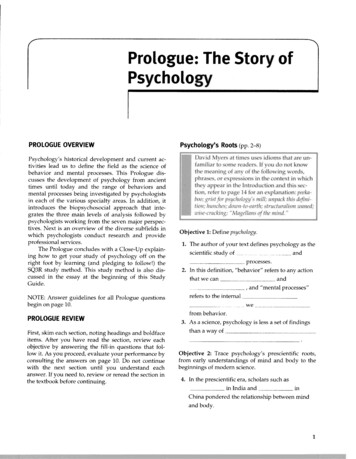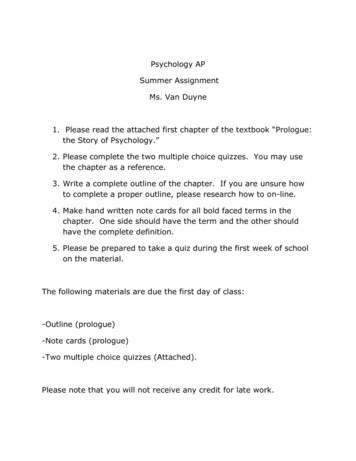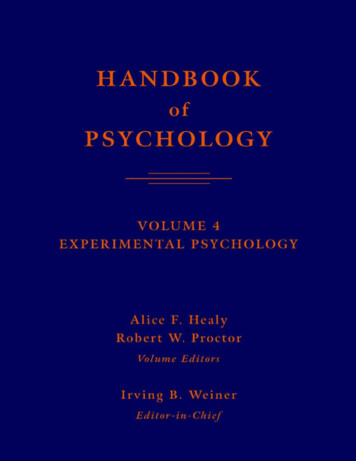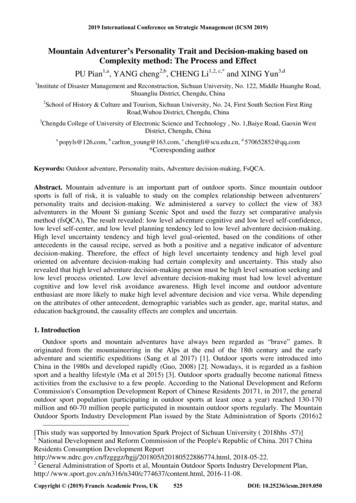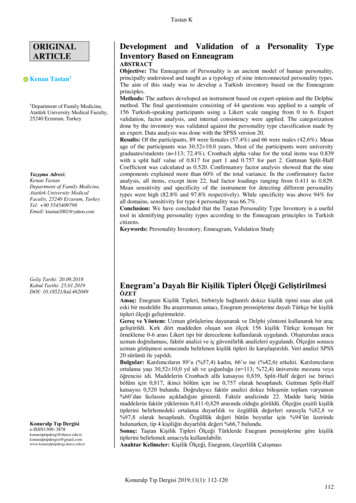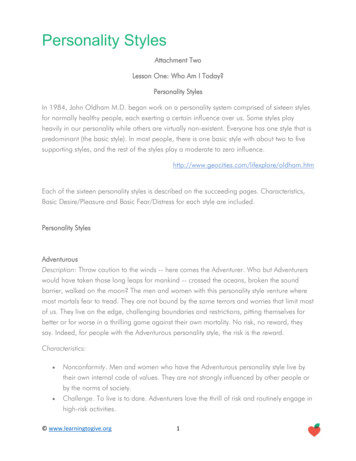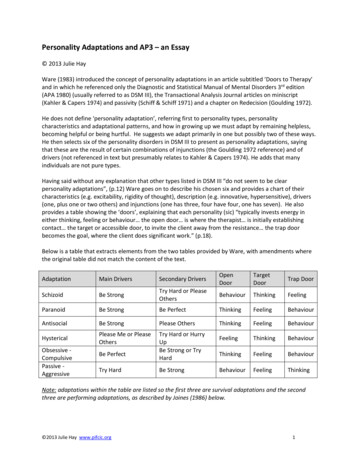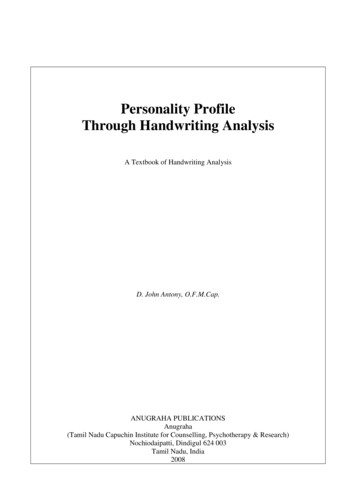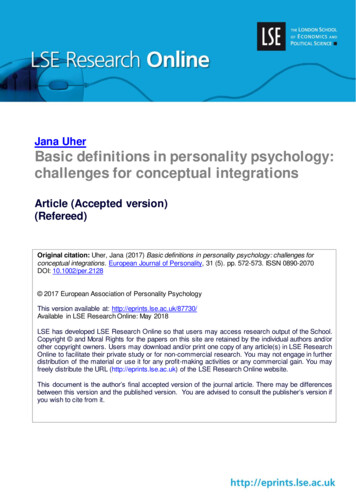
Transcription
Jana UherBasic definitions in personality psychology:challenges for conceptual integrationsArticle (Accepted version)(Refereed)Original citation: Uher, Jana (2017) Basic definitions in personality psychology: challenges forconceptual integrations. European Journal of Personality, 31 (5). pp. 572-573. ISSN 0890-2070DOI: 10.1002/per.2128 2017 European Association of Personality PsychologyThis version available at: http://eprints.lse.ac.uk/87730/Available in LSE Research Online: May 2018LSE has developed LSE Research Online so that users may access research output of the School.Copyright and Moral Rights for the papers on this site are retained by the individual authors and/orother copyright owners. Users may download and/or print one copy of any article(s) in LSE ResearchOnline to facilitate their private study or for non-commercial research. You may not engage in furtherdistribution of the material or use it for any profit-making activities or any commercial gain. You mayfreely distribute the URL (http://eprints.lse.ac.uk) of the LSE Research Online website.This document is the author’s final accepted version of the journal article. There may be differencesbetween this version and the published version. You are advised to consult the publisher’s version ifyou wish to cite from it.
Uher, J. (2017). Basic Definitions in Personality Psychology: Challenges for Conceptual Integrations.European Journal of Personality, 31, 572-573 taryBasic definitions in personality psychology:Challenges for conceptual integrationsJana Uher 1*1London School of Economics and Political Science, United Kingdom* Correspondence:London School of Economics and Political ScienceHoughton Street, WC2A2AE London, United Kingdommail@janauher.comTel: 44-(0)20-7852 3793AbstractPersonality psychology is fragmented across heterogeneous subfields each focussing onparticular aspects of individuals and from particular paradigmatic perspectives. Attempts forintegration into overarching theories as that presented in the target article are thereforeimportant. But the ideas proposed build on vague and often circular definitions of basic termsand concepts that hamper advancement and integration. My critique from philosophy-ofscience perspectives pinpoints central problems and presents alternative concepts to helpovercome them. A metatheoretical definition highlights the core ideas underlying commonpersonality concepts and opens new avenues for conceptual integration.Conceptual integrations presuppose clear definitions of basic terms and concepts.Personality psychology encounters particular challenges because its objects of research arephenomena of daily social life about which every person, including scientists, possessescomprehensive lay-psychological knowledge and vocabulary (Uher, 2011, 2015a). But unlikescientific concepts and terms, everyday concepts and terms are often fuzzy and contextsensitive (Hammersley, 2013) and contain circular explanations (Laucken, 1974; Uher, 2013,2015b,c). Despite all scholarly efforts, this challenges psychologists’ abilities tounambiguously define basic terms and to make explicit their most basic concepts. I applaudthe authors for highlighting the necessity of clear definitions and for providing workingdefinitions. But instead of going beyond pre-existing concepts, they adopt vague and circularideas from previous definitions. More precise terms and definitions may be cumbersome butare of utmost importance to overcome the field’s current conceptual disintegration.Definition of behaviourThe broad definition of behaviour (Appendix) as “everything an organism does” failsto exclude doings not commonly considered behaviours, such as organisms’ metabolismand growth (Millikan, 1993). Including “observable actions, covert actions, cognitions,motivations, and emotions” in the set of phenomena defined as behaviour entailsfundamental circularity in explanation, for how can broadly defined behaviours be explainedby underlying affections, cognitions and motivations if these phenomena constitutebehaviours themselves? Why do we use such different terms at all if not to highlightessential differences among the phenomena they denote (Uher, 2016a)?http://researchonindividuals.org
Uher, J. (2017). Basic Definitions in Personality Psychology: Challenges for Conceptual Integrations.European Journal of Personality, 31, 572-573 http://dx.doi.org/10.1002/per.21282/4Definition of personalityThe same circularity is entailed when defining personality as “a person’scharacteristic pattern of behaviors in the broad sense (including thoughts, feelings, andmotivation)” (Appendix). When patterns in cognition, emotion and motivation form inherentparts of someone’s personality, they cannot also serve as explanations. What phenomenaother than those included in the definition can explain those conceived as personality?Contradicting their own working definition, the authors discuss various affective, cognitiveand motivational processes that may causally contribute to the emergence of personalityvariation. Given this, what criteria define some psychical phenomena as forming part ofpersonality but others only as their causes or consequences (Uher, in press)? The notion of“characteristic patterns” is surprisingly vague for a scientific definition. When are behaviouralpatterns “characteristic” enough for an individual to constitute “tendencies” and to warranttheir interpretation as personality? That is, what differentiates behaviour from personality(Uher, 2013, 2015a; Uher & Visalberghi, 2016)?Definition of structureThe target article mostly defines personality structure as “inter-individual differences”(Part 1), thus clearly denoting a population-level concept. But the working definition(Appendix) also refers to the individual-level concept of organisation “within individuals”. Thediscipline’s founder, William Stern (1911), already highlighted essential differences betweenthese two fundamental perspectives on individuals (i.e., differential psychology andpersonality psychology). The structure of personality differences in a population cannotreveal anything about the structure of an individual’s personality or its underlying causes asthe authors ascertain correctly. Clear terminological differentiations are essential to integratethese different structural concepts with concepts of personality processes and development,which inherently occur at the individual level (Uher, 2011, 2015c).Definition of process and developmentThe authors oppose processes and development as different concepts but, at thesame time, define processes as implying development (Appendix). The established conceptsof microgenesis (Aktualgenese) and ontogenesis may provide more clarity for differentiatingdevelopmental processes and a solid theoretical basis for the ideas presented (Diriwächter &Valsiner 2008; Rosenthal, 2002; Uher, 2015c).Definition of traits and trait levelsTraits defined as “relatively stable inter-individual differences in thedegree/extent/level of coherent behaviors, thoughts, feelings” clearly denote a populationlevel concept. But traits are also interpreted as internal entities that may share underlyingprocesses (Part 1), thus reflecting an individual-level concept. As the authors state correctly,different underlying psychical and physiological processes may be associated with similarobservable behaviours in concrete situations, and vice versa. But given this and given thatall of these phenomena together define a “trait”, what actually constitutes an individual’s “traitlevel”? Commonly, individuals’ trait levels are determined as scores of assessment scales.But assessments are retrospective and memory-based methods. How can they measureindividuals’ thoughts, feelings and observable behaviours, which are highly fluctuatingphenomena that can thus be captured only in the moments in which they occur (Uher, 2013,2015a; Uher & Visalberghi, 2016)?These and further fundamental questions of personality psychology were explored byapplying the Transdisciplinary Philosophy-of-Science Paradigm for Research on Individuals(TPS Paradigm), a paradigm aimed toward making explicit and scrutinising the most basicassumptions different disciplines make about individuals and the metatheories andmethodologies used. It metatheoretically defines and differentiates various kinds ofphenomena studied in individuals: morphology, physiology, psyche, behaviours, contexts,semiotic representations (language) and artificial outer-appearance modifications. Forhttp://researchonindividuals.org
Uher, J. (2017). Basic Definitions in Personality Psychology: Challenges for Conceptual Integrations.European Journal of Personality, 31, 572-573 http://dx.doi.org/10.1002/per.21283/4example, behaviours are conceived as phenomena occurring entirely external to individual’sbodies that are therefore publicly accessible. Psychical phenomena, by contrast, areconceived as occurring entirely internally that are therefore inaccessible by others (fordefinitions, see Uher, 2015a, 2016a,b).The paradigm’s frameworks were used to elaborate a metatheoretical definition ofpersonality that embraces the ideas contained in previous definitions. It highlights that thecentral idea of personality concepts is individual specificity for which clear criteria areelaborated and that is studied in the various kinds of phenomena explored in individuals.This definition allows researchers to specify the particular phenomena in which they studyindividual specificity rather than using the abstract personality label uniformly for phenomenaof very different kinds, thereby obscuring vital differences. Researchers can also specifywhich phenomena they explore as study phenomena and which as their causes orconsequences, thus avoiding the circularity contained in previous personality definitions(Uher, in press, 2013, 2015a,c).The TPS Paradigm highlighted that meaningful conceptual integrations requireindividual-specific structures and processes to be identified and categorised using betweenindividual and within-individual approaches complementarily and step-wise (the so-calledHourglass-shape methodology). The configurational and process structures of individualspecific variations, identified separately in each given kind of phenomenon (e.g., behaviour,psyche, physiology), are then set in relation to one another to identify functional and causalinterrelations as well as patterns of longitudinal development (Uher, 2015b,c).AcknowledgementsThe author gratefully acknowledges funding from a Marie Curie Fellowship of the EuropeanCommission’s FP7 Programme (EC Grant Agreement number 629430).ReferencesDiriwächter, R. & Valsiner, J. (2008). Striving for the whole: Creating theoretical syntheses.(Eds.). Somerset, NJ: Transaction Publishers.Hammersley, M. (2013). The myth of research-based policy and practice. London: SageLaucken, U. (1974). Naive Verhaltenstheorie. Stuttgart: Klett.Millikan, R. (1993). White queen psychology and other essays for Alice. Cambridge, MA:Bradford Books/ MIT Press.Rosenthal, V. (2004). Microgenesis, immediate experience and visual processes in reading.In A. Carsetti (Ed.), Seeing, thinking and knowing—Meaning and self-organisationin visual cognition and thought, (pp. 221–243). Kluwer Academic Publishers.Stern, W. (1911) Die differentielle Psychologie in ihren methodischen Grundlagen (2.Auflage). [Differential Psychology in its methodological foundations (2nd ed)]. Barth,Leipzig.Uher, J. (in press). The Transdisciplinary Philosophy-of-Science Paradigm for Research onIndividuals: Foundations for the science of personality and individual differences. InV. Zeigler-Hill & T. K. Shackelford (Eds). The SAGE Handbook of Personality andIndividual Differences. Vol. 1. The Science of Personality and IndividualDifferences. Part 1: Theoretical Perspectives on Personality and IndividualDifferences. London, UK: Sage.Uher, J. (2011). Individual behavioral phenotypes: An integrative meta-theoreticalframework. Why 'behavioral syndromes' are not analogues of 'personality'.Developmental Psychobiology, 53, 521–548.Uher, J. (2013). Personality psychology: Lexical approaches, assessment methods, and traitconcepts reveal only half of the story. Why it is time for a paradigm shift. IntegrativePsychological and Behavioral Science, 47, 1-55.http://researchonindividuals.org
Uher, J. (2017). Basic Definitions in Personality Psychology: Challenges for Conceptual Integrations.European Journal of Personality, 31, 572-573 http://dx.doi.org/10.1002/per.21284/4Uher, J. (2015a). Conceiving "personality": Psychologists’ challenges and basicfundamentals of the Transdisciplinary Philosophy-of-Science Paradigm forResearch on Individuals. Integrative Psychological and Behavioral Science, 49,398-458.Uher, J. (2015b). Developing "personality" taxonomies: Metatheoretical and methodologicalrationales underlying selection approaches, methods of data generation andreduction principles. Integrative Psychological and Behavioral Science, 49, 531589.Uher, J. (2015c). Interpreting "personality" taxonomies: Why previous models cannot captureindividual-specific experiencing, behaviour, functioning and development. Majortaxonomic tasks still lay ahead. Integrative Psychological and Behavioral Science,49, 600-655.Uher, J. (2016a). What is behaviour? And (when) is language behaviour? Journal for theTheory of Social Behaviour, 46, 475-501.Uher, J. (2016b). Exploring the workings of the psyche: metatheoretical and methodologicalfoundation. In J. Valsiner, G. Marsico, N. Chaudhary, T. Sato, and V. Dazzani(Eds.). Psychology as the Science of Human Being: the Yokohama Manifesto.Annals of theoretical psychology, Vol 13 (pp. 299-324). Cham, SpringerInternational. https://doi.org/10.1007/978-3-319-21094-0 18Uher, J., & Visalberghi, E. (2016). Observations versus assessments of personality: A fivemethod multi-species study reveals numerous biases in rati
Conceptual integrations presuppose clear definitions of basic terms and concepts. Personality psychology encounters particular challenges because its objects of research are phenomena of daily social life about which every person, including scientists, possesses comprehensive lay-psychological knowledge and vocabulary (Uher, 2011, 2015a). But .
